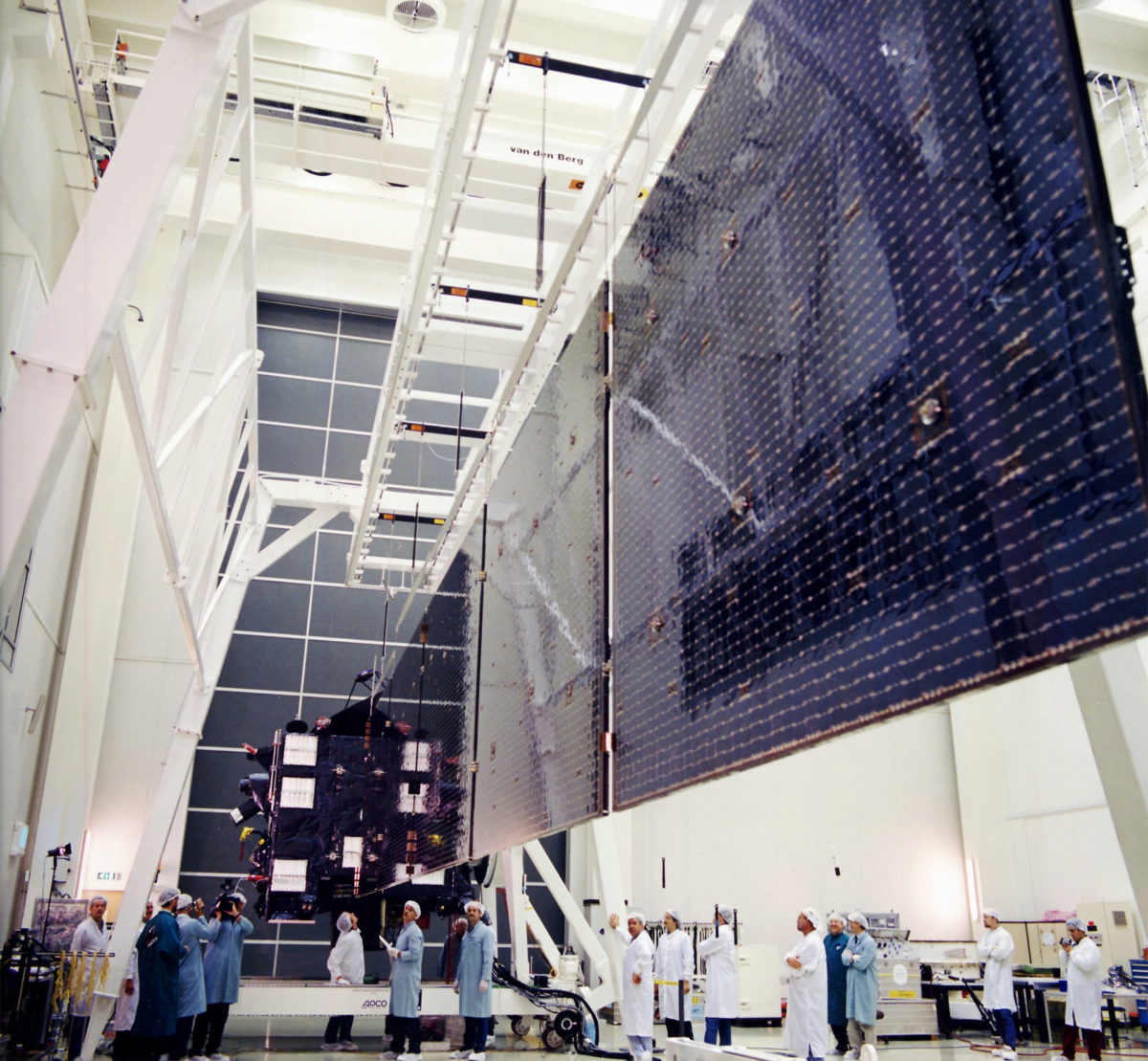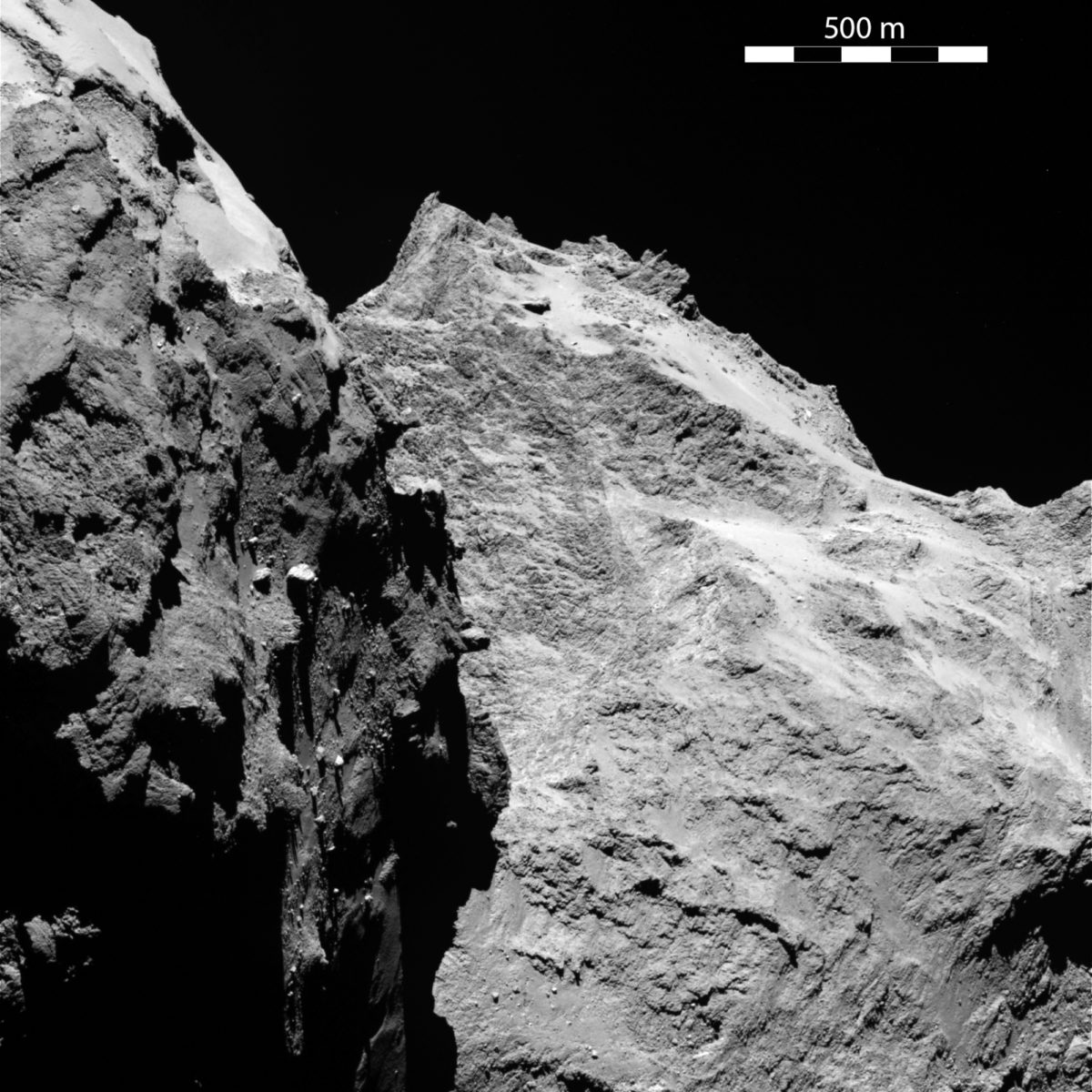Emily Lakdawalla • Sep 11, 2014
New Rosetta views and first science on comet Churyumov-Gerasimenko from EPSC
Just weeks after their arrival at comet Churyumov-Gerasimenko, the Rosetta science team showcased their first results at the European Planetary Science Congress. The session included results from most of the science teams, but arguably the most exciting "result" to come out of the mission this week was this view of the comet -- and the spacecraft studying it -- from the Philae lander. I've flipped the image 180 degrees so that the Sun appears to be illuminating it from the top.

The comet was brightly sunlit, but Philae and its cameras were on the shadowed side of the spacecraft and we're looking at the undersides of the solar panels (whose topsides are facing where they should be, toward the Sun). I was having trouble understanding the lighting geometry of this image because of what looked like bright hinges between the solar panels. So I went to dig up some photos of the solar panels under testing:

And here's a related view, in which you can see how Philae is bolted to the spacecraft, with the panels folded at the side:

If you look closely at the joints between the panels, you can see that they are connected with some flexible electronic tape, a tape that is transparent. In the CIVA image of Rosetta at the comet, we're seeing the shaded backsides of the solar panels, but the Sun can shine through and into the tape that connects the panels, and some of that light is scattered toward the camera, making them appear bright. CIVA is a panoramic camera instrument, designed to capture the view around Philae once it lands on the comet. Most panoramic camera instruments on landers are single cameras on a rotating mast, but Philae's panoramic camera doesn't have moving parts; instead, it has six micro-cameras pointed in fixed directions. While Philae is attached to Rosetta, the two side cameras can see both of the solar panels. Handy! It has to be awesome for the team to be able to see the hardware they built, out there in space with the comet behind.
Philae's panoramic camera Rosetta's lander Philae is equipped with the CIVA instrument (Comet Infrared and Visible Analyser). CIVA has six microcameras used to take panoramic pictures. This artist’s impression shows Philae using CIVA to create a panoramic view of its surroundings. The comet surface is an artist’s impression.Video: ESA / ATG medialab
So, on to science. For me, one of the most exciting pieces of news was that the COSIMA instrument has successfully collected comet dust and is ready to use its ion gun to turn the grains into ions and measure their composition with the instrument's ion mass spectrometer. "These are among the first dust grains to have been collected from beyond the Solar System’s snow line – the distance from the Sun at which ice grains can form," COSIMA principal investigator Martin Hilchenbach wrote in a blog post about the team's results.

Both the ALICE ultraviolet spectrometer and the VIRTIS visible and infrared spectrometer are forming a picture of the comet as a very dark, relatively warm surface that lacks exposed water ice. "The new VIRTIS measurements have allowed the team to rule out some models of the comet surface and to favour a comet surface composed of a porous and highly thermally insulating dusty crust that is depleted of water ice. As they reported today, this is also consistent with the VIRTIS global measurements of thermal inertia – a measure of a body’s resistance to changes in temperature – that is compatible with the value for high porosity dusty materials," VIRTIS PI Fabrizio Capaccioni wrote in a blog entry about his team's results. Alice has, however, detected the byproducts of water ice in the comet's coma.
And, finally, there was a new OSIRIS image of the comet. Almost all of the pictures that you have seen from the comet so far have come from the NavCam; this is the first OSIRIS photo in about a month, and only the second one ever that demonstrates how amazing the OSIRIS data set on the comet is going to be, in all its 4-megapixel glory. OSIRIS is the biggest framing camera on a deep-space mission; its 2048-pixel-square photos are worth examining in all their incredible detail. By popular demand, I have added a scale bar onto the photo.

The area of this image overlaps slightly with the area in the previous OSIRIS image. The previous OSIRIS release was a 3D one -- two photos taken from slightly different positions -- and that allowed amateur image processor Mattias Malmer to create a shape model of the comet. He used that high-resolution shape model to produce this synthetic 3D view of a part of the area covered by the OSIRIS image above. Grab your red-blue glasses and enjoy (or use one of the links below to see the 3D another way):

I was not at the European Planetary Science Congress meeting, but Pamela Gay was, and she was tweeting furiously. Here are some highlights of her tweets from the EPSC Rosetta session:
Aug 3, 5.5 m/pix resolution achieved. Unclear - is this a contact binary, or … what? #EPSC2014 Land where? Need flat. pic.twitter.com/N0UD6yw2ec
— Pamela L. Gay (@starstryder) September 8, 2014Showing amazing @ESA_Rosetta images of boulders all over CG 67P. Also, layered regions, blocks, and plates. #EPSC2014
— Pamela L. Gay (@starstryder) September 8, 2014Also finding weird circular depressions. Not craters. Shock impacts? still sorting. #EPSC2014 pic.twitter.com/I8hxeQ2eNT
— Pamela L. Gay (@starstryder) September 8, 2014Landing site criteria include engineering & science constraints. Can't get everywhere on nucleus & environment matters #EPSC2014
— Pamela L. Gay (@starstryder) September 8, 2014Landing site needs Sun 7-8hr/day for power, but want day-night cycle, also onsite gas&dust activity, organics, & not too sloped #EPSC2014
— Pamela L. Gay (@starstryder) September 8, 2014. @ESA_Rosetta has 4 possible landing sites - 3 on head, 2 on body of "duck" - but all riskier than hoped #EPSC2014 pic.twitter.com/VmkyHR2iOt
— Pamela L. Gay (@starstryder) September 8, 2014Q: What happens if @ESA_Rosetta doesn't land on feet? A: Bad if on head. If side, may be able to do sci w exposed instruments #EPSC2014
— Pamela L. Gay (@starstryder) September 8, 2014The main threat to the @Philae2014 lander is the slope of the terrain itself, according to the Philae Science team. #EPSC2014
— Jakub Bochinski (@JakubBochinski) September 8, 2014Shape of this rotating, duck-shaped comet is "major pain in the bum" for constraining @ESA_Rosetta @Philae2014 landing sites #EPSC2014
— Pamela L. Gay (@starstryder) September 8, 2014The activity of the comet (e.g. jets) can perturb orbit of @ESA_Rosetta. Need to predict effects before effects start. But how?#EPSC2014
— Pamela L. Gay (@starstryder) September 8, 2014Based on current activity at 3.5 AU etc, looks like CG 67P slightly more active than minimum activity model, but watching closely #EPSC2014
— Pamela L. Gay (@starstryder) September 8, 2014Showing gravitational potential models for CG 67P. Works well with model of two ellipses (+ lumps) with 2.6km between centers #EPSC2014
— Pamela L. Gay (@starstryder) September 8, 2014The neck of CG 67P is at or less than 2.4 km^3 of material = tiny. Unusual lack of alignment in lobes hints at joined structure #EPSC2014
— Pamela L. Gay (@starstryder) September 8, 2014Finally, I'll leave you with the most recent NavCam view of the comet:

Let’s Go Beyond The Horizon
Every success in space exploration is the result of the community of space enthusiasts, like you, who believe it is important. You can help usher in the next great era of space exploration with your gift today.
Donate Today

 Explore Worlds
Explore Worlds Find Life
Find Life Defend Earth
Defend Earth

